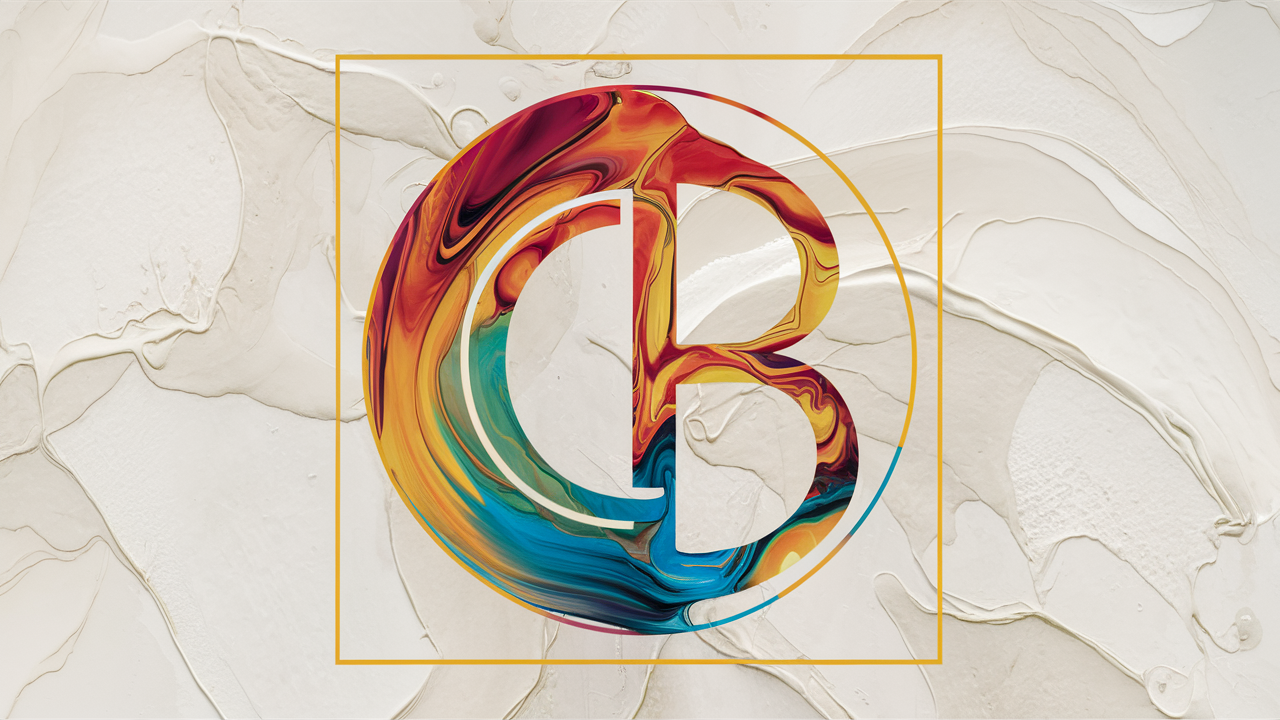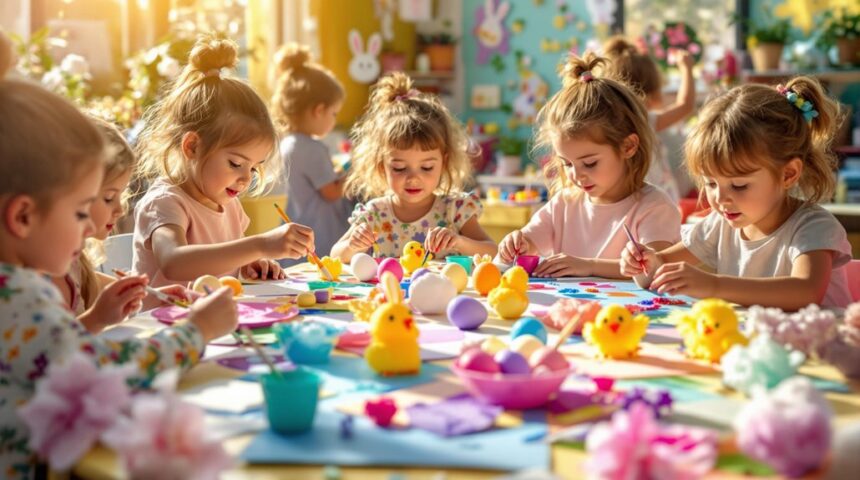Creating Easter art in kindergarten is a fun adventure! Start by gathering craft paper, paints, and fun items like stickers or twigs. Explore simple shapes like circles and triangles for eggs and bunny ears. Let the kids paint, stamp, and mix colors, creating their masterpieces. Feel the magic with textures from sandpaper or cotton balls. Encourage them to tell their own stories through art. Finally, display their works proudly—Easter creativity has never been this exciting! Want more tips for an artistic Easter?
Key Takeaways
- Gather essential materials like craft paper, non-toxic paints, and decorative items for Easter art projects.
- Introduce children to simple shapes such as circles and triangles to inspire creativity.
- Encourage shape combinations and painting techniques, like sponge painting, for unique Easter designs.
- Experiment with textures using materials like cotton balls and twigs to enhance sensory experiences.
- Promote collaboration and storytelling in art projects, fostering teamwork and imaginative play.
Gathering Essential Materials
When it comes to creating Easter art in kindergarten, gathering essential materials is like setting the stage for a grand adventure.
Imagine a world where craft paper transforms into easy Easter crafts, and non-toxic paints swirl in vibrant colors. The excitement builds as supplies like colored construction paper, glue sticks, and markers come together, ready to bring imaginative ideas to life.
Decorative items such as stickers, washi tape, and pom-poms add a sprinkle of magic, turning simple projects into extraordinary creations. For the brave and bold, natural materials like twigs, leaves, and flowers offer a touch of nature’s wonder.
With cupcake liners and paper plates at hand, the possibilities for Easter crafts for kids become endless, promising a joyful crafting experience.
Exploring Simple Shapes
Exploring simple shapes like circles, triangles, and squares opens up a world of creativity for young artists, especially when it comes to making Easter-themed crafts.
Imagine combining triangles as bunny ears or using circles to decorate colorful Easter eggs—it’s like a puzzle where every piece has its place.
Teachers can turn this into a fun challenge, encouraging kids to mix and match shapes to create their own unique designs, all while sneakily learning about geometry.
Identifying Basic Shapes
Shapes are everywhere! Kids in kindergarten can spot basic shapes like circles and triangles all around them, even in their Easter crafts. It’s amazing how these simple shapes can transform into fun art projects. Circles can become bunny heads, and triangles make perfect ears!
As children explore these shapes, they also immerse themselves in the world of color recognition. Choosing the right colors for their art adds an extra splash of creativity.
Imagine a room full of little artists, each busy identifying and sorting shapes. These activities not only make learning fun but also sharpen their fine motor skills. They might even giggle as they match shapes, turning a simple task into an exciting Easter adventure. Who knew shapes could be so thrilling?
Shape Combination Ideas
Easter art projects become a playground for creativity when kindergarteners start combining simple shapes. Imagine the fun of using circles for bunny bodies and triangles for ears—it’s like a puzzle but with Easter craft ideas!
Kids can overlap shapes to make intricate designs, like an oval egg adorned with tiny circular patterns. It’s a colorful collage adventure, where cut-out shapes from vibrant paper form enchanted Easter scenes.
Then, there’s the magic of symmetry. Encouraging children to create symmetrical butterfly shapes is a delightful challenge. They learn about balance and beauty, crafting Easter butterflies with identical wings.
As they name and recognize each shape, they’re not just making art—they’re diving into geometry, too. Who knew learning could be so egg-citing?
Using Shapes Creatively
Imagine the surprise when kindergartners find out that basic shapes have superpowers! Circles, triangles, and squares transform into festive Easter art, like bunnies and eggs. With geometric shapes, creating is easy to make. Kids can cut colored paper into shapes, then layer and combine them into unique collages. Imagine Easter eggs adorned with bunny ears—adorable, right? They can explore the world of 3D too, crafting a pyramid-shaped bunny or a spherical Easter egg. It’s all about using those geometric shapes to ignite creativity and spatial awareness.
Here’s how it breaks down:
| Shape | Easter Art | Materials |
|---|---|---|
| Circle | Easter egg | Colored paper |
| Triangle | Bunny ears | Stencils |
| Square | Collage base | Scissors |
| Combined | 3D Models | Glue |
Art and math, a perfect duo!
Incorporating Painting Techniques
Dive right into the colorful world of painting techniques that make Easter art projects in kindergarten both fun and educational!
Imagine an Easter bunny hopping across a canvas, brought to life with vibrant splashes of acrylic paint. Young artists can create a beautiful Easter scene using techniques that little ones will love.
Start with washable, non-toxic paints, ensuring safety while exploring creativity. The marbled effect is magical—blend food coloring into shaving foam, swirl it around, and press paper onto it for a masterpiece.
Sponge painting with egg-shaped sponges also adds a delightful twist. Using brushes of different sizes, kids can master fine lines or bold strokes.
With nature-inspired pastel shades, these art projects truly capture the spirit of springtime!
Adding Vibrant Colors With Stamping
Stamping is like a magic trick for little artists, transforming ordinary objects into tools for creating colorful masterpieces! Imagine the excitement of an Easter egg hunt, but on paper, as kids use vibrant colors to bring their art to life.
With washable paint, parents and teachers can breathe easy, knowing that cleanup is a breeze. Kids dip potatoes, sponges, or even leaves into the paint, stamping delightful patterns that reflect seasonal themes like Easter eggs, bunnies, and flowers.
This hands-on activity not only sparks creativity but also boosts fine motor skills. Once the stamping fun is over, it’s important to let the artwork dry completely. This guarantees the colors stay bold and don’t end up looking like a tie-dye experiment gone wrong!
Experimenting With Textures
Exploring textures in Easter art can be a fun and messy adventure for kindergarteners, filled with giggles and surprises.
Imagine the thrill of squishing cotton balls, rubbing sandpaper, or even stamping with bubble wrap to create wild patterns on their crafts.
Explore Various Materials
When it comes to Easter art, a world of textures awaits young artists, ready to be explored with excitement and creativity.
Imagine little fingers diving into fluffy cotton balls, smoothing out tissue paper, or brushing against rough sandpaper. It’s like a buffet of textures! Kids are encouraged to explore different textures, mixing in natural elements like leaves, twigs, and flowers to craft their masterpieces.
Want to see magic happen? Hand them some fabric scraps, beads, and buttons for collage-making with diverse materials.
This adventure doesn’t stop there—layering different textured papers, such as crepe or origami paper, adds depth and interest. These materials not only make art fun but also teach kids how combining textures creates something truly special.
It’s texture heaven!
Sensory Experience for Kids
Imagine the joy of feeling textures in art class—it’s like a sensory playground for little hands! Kids engage in Easter art by crafting Salt dough Easter eggs. This easy DIY project lets them mold dough, boosting fine motor skills. Adding green craft paint gives a vibrant splash, making it a fun, textured experience for kids and adults alike. Using finger and sponge painting, children explore paint’s texture, discovering how it feels on surfaces like sandpaper and fabric.
| Material | Texture Experience |
|---|---|
| Salt Dough | Moldable and soft |
| Green Craft Paint | Smooth and colorful |
| Sandpaper | Rough and gritty |
| Cotton Balls | Soft and fluffy |
| Fabric | Varied textures (smooth, rough) |
Incorporating leaves or petals, they connect with nature, enriching their sensory adventure.
Encouraging Creative Expression
While creativity might seem like a magical gift, it actually grows stronger with practice, especially in young children. Encouraging creative expression in kindergarten is like a fun adventure.
Egg decorating isn’t just about making colorful eggs; it’s a fantastic way to boost fine motor skills and artistic creativity. Imagine a room filled with paints, markers, and all sorts of materials—kids get to explore different textures and colors, sparking their imaginations.
Collaborative art projects, like crafting a huge Easter-themed mural, turn into epic teamwork missions. Everyone pitches in, sharing ideas and creating something truly special.
Plus, with storytelling elements, like dreaming up characters from Easter tales, kids immerse themselves in worlds they create, making their art personal and unique.
Displaying and Celebrating Artwork
Few things light up a room quite like a vibrant display of children’s artwork, especially when it’s bursting with Easter colors and creativity.
Imagine an Easter table, an inviting display area where kids’ masterpieces hang proudly. Colorful string and clothespins transform simple walls into a gallery of seasonal themes, from bunnies to eggs, all enthusiastic to celebrate the holiday spirit.
Organizing an Easter art exhibition allows children to showcase their talents to family and friends. This event is more than just pretty pictures—it’s a chance for kids to share the stories behind their creations, boosting their confidence and communication skills.
Sharing these creative endeavors on social media or a class newsletter extends the celebration, letting everyone join in the admiration.
Frequently Asked Questions
How to Make Easter Crafts for Kids at Home?
To create Easter crafts at home, one can use paper plates for bunny masks, enhance with vibrant colors, and add spring flowers. Decorating Easter eggs and incorporating colorful decorations can make the crafting experience enjoyable for kids.
How Do You Make an Easy Easter Basket?
Creating an easy Easter basket involves selecting Easter basket materials like colorful paper for a vibrant design. DIY basket handles can be crafted easily. Fun basket fillers and kid-friendly decorations add a playful touch to these delightful creations.
How to Make Easter Magical for Kids?
To make Easter magical for kids, incorporate Easter egg hunts, bunny decorations, and spring themes. Emphasize family traditions and festive treats. These elements create memorable experiences, filling the occasion with joy and wonder for young participants.
Conclusion
In the end, creating Easter art with kindergarteners is all about having fun and letting creativity run wild. By gathering the right materials, playing with shapes, and adding a splash of color, young artists can explore their imaginations. Throw in some stamping and textures, and watch their masterpieces come to life! It’s like having a mini art party where everyone gets to be Picasso for a day. So, get ready to display those delightful creations and celebrate the joy of art!


Leave a Reply